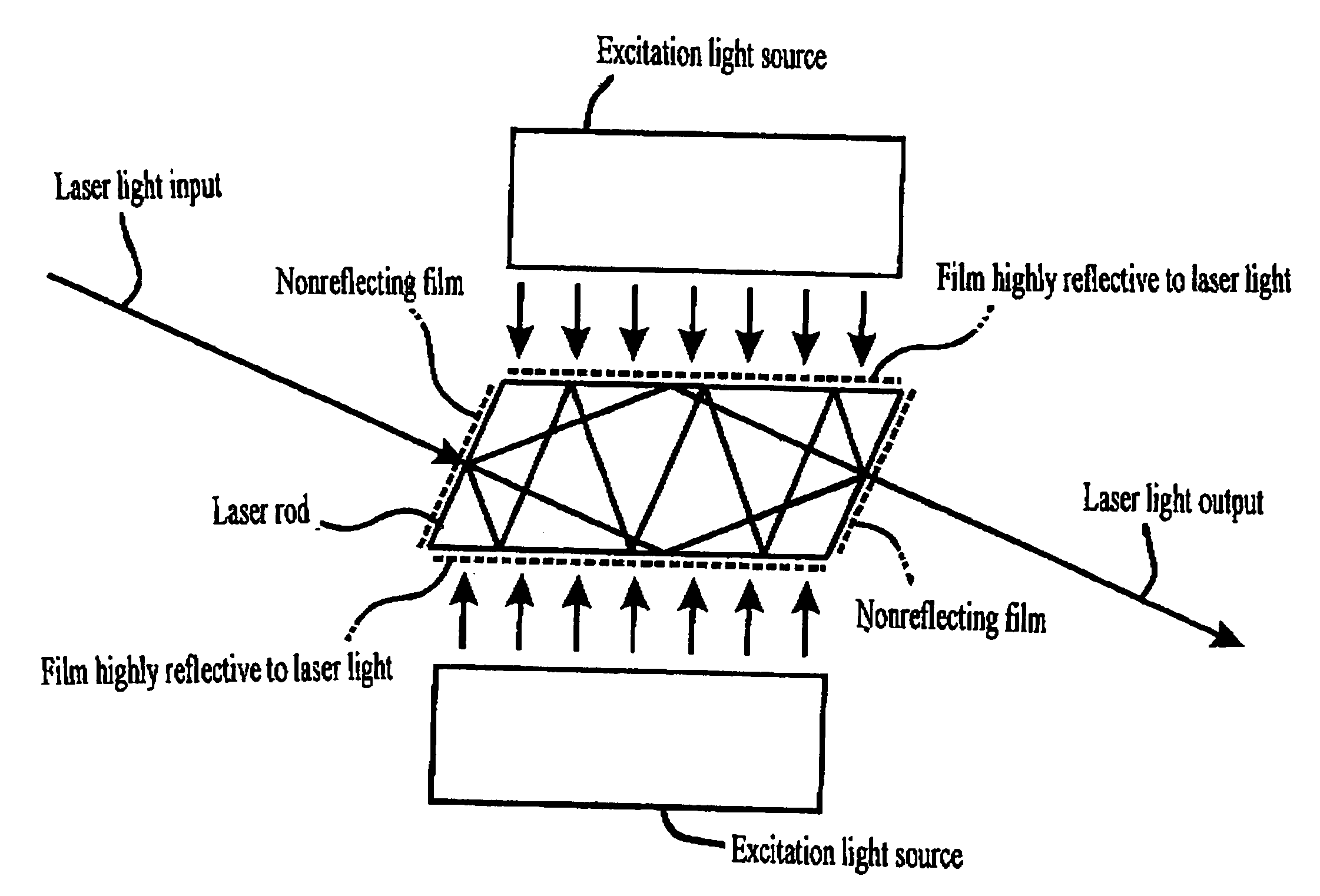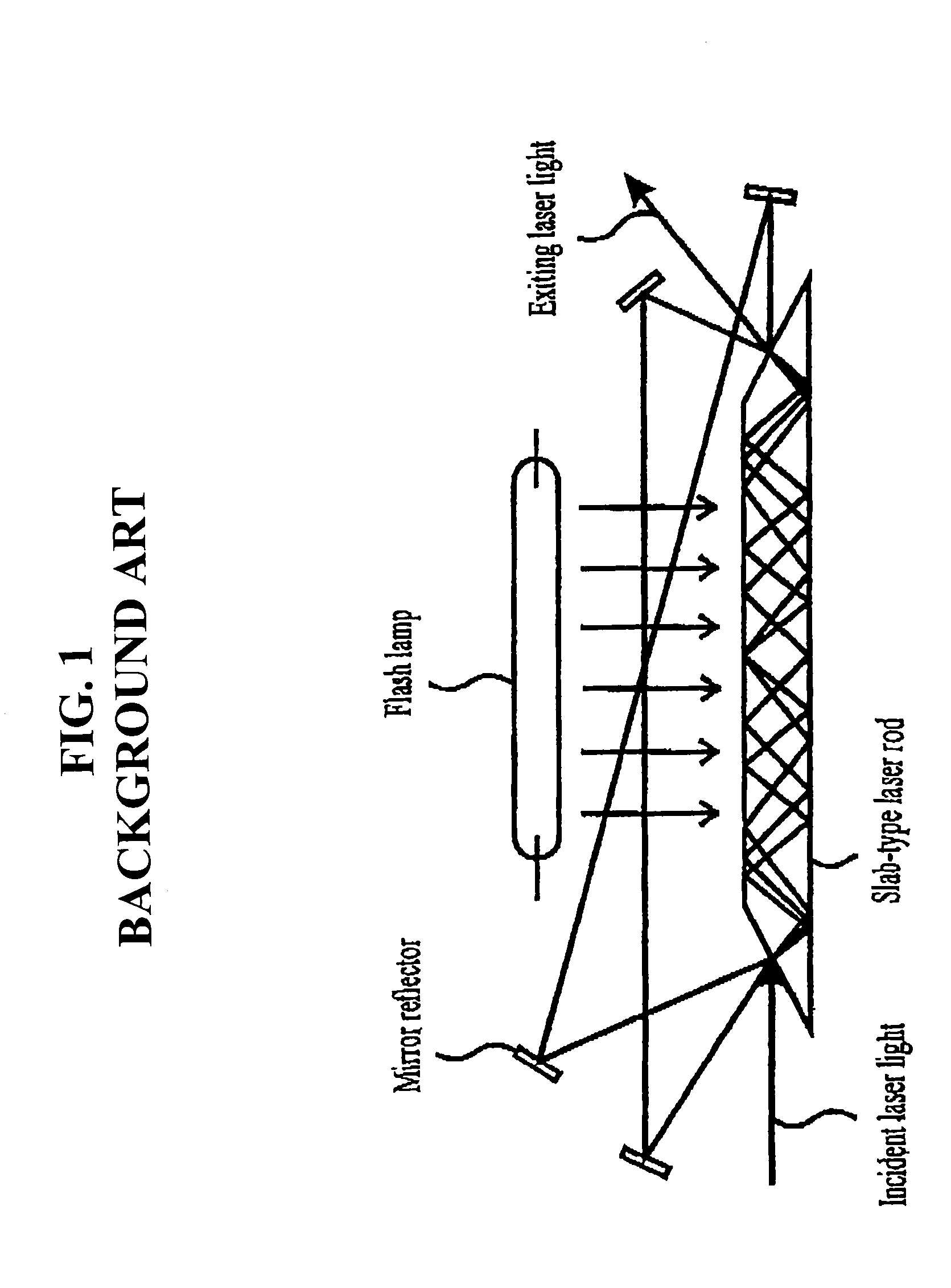Multipath laser apparatus using a solid-state slab laser rod
a laser apparatus and multi-path technology, applied in the direction of laser cooling arrangements, laser details, excitation process/apparatus, etc., can solve the problems of poor efficiency of electricity to light conversion by the lamp itself, large power consumption of laser apparatus, and insufficient power consumption
- Summary
- Abstract
- Description
- Claims
- Application Information
AI Technical Summary
Benefits of technology
Problems solved by technology
Method used
Image
Examples
embodiment 1
[0125]The solid-state slab laser rod in the laser apparatus according to the present invention has a cross section in the shape of a long, thin trapezoid- or parallelogram-shaped slab as shown in FIG. 3 or FIG. 4. Each of the four faces 10, 11, 12 and 13 perpendicular to the plane of the paper is optically polished and a laser light-reflecting film is applied to the upper and lower long side faces 12 and 13. Laser light does not come into contact with the two faces that are parallel to the plane of the paper, so they may be either polished faces or left as rough faces.
[0126]A light beam 1 that is incident at the Brewster angle upon end face 10 of the laser rod travels along path 2 within the interior of the rod as its initial optical path, being reflected by the side faces until reaching end face 11. Here, end face 11 is inclined with respect to the central axis of the rod, so the light is totally reflected and then travels along path 3 at a larger angle from the central axis as its...
embodiment 2
Linking in Series
[0150]Long rods disposed with the same triple paths can be manufactured by using the laser rods described above as basic cells, and conceptually linking identical cells in series at their end faces. In order to construct a triple path, it is necessary to add two basic cells at a time to the basic cell. This is in order to maintain the relationship of odd and even numbers in the number of reflections at the side faces present in the basic cells also in the linked rods. FIGS. 7 and 8 show examples of laser rods formed by linking three each of the basic cells with a number of side-face reflections of (2, 3) and (3, 4).
[0151]In the case of trapezoidal basic cells, they are linked linearly by vertically inverting each one in sequence. Parallelogram-shaped basic cells are linked without inverting.
embodiment 3
Linking in Parallel
[0152]Alternately, triple or higher multiple paths can be disposed in rods formed by linking two basic cells in parallel at their side faces. Trapezoidal basic cells can be linked so that they are symmetrical about the connected faces. The completed rod has a hexagonal cross section. FIG. 9 shows an example of the linking of basic cells with numbers of side-face reflections of (2, 3). Two sets of triple paths are formed in this rod.
[0153]Two parallelogram-shaped basic cells are linked by the linear translation of one of the basic cells. The completed parallel-linked rod becomes a rod with a parallelogram-shaped cross section, as expected. FIG. 10 shows an example of the linking of basic cells with numbers of side-face reflections of (3, 4). One set of quintuple paths is formed in this rod.
[0154]In the above linked rods and those to be presented hereinafter, the way of thinking of the number of side-face reflections is to be such that when light passes through the ...
PUM
 Login to View More
Login to View More Abstract
Description
Claims
Application Information
 Login to View More
Login to View More - R&D
- Intellectual Property
- Life Sciences
- Materials
- Tech Scout
- Unparalleled Data Quality
- Higher Quality Content
- 60% Fewer Hallucinations
Browse by: Latest US Patents, China's latest patents, Technical Efficacy Thesaurus, Application Domain, Technology Topic, Popular Technical Reports.
© 2025 PatSnap. All rights reserved.Legal|Privacy policy|Modern Slavery Act Transparency Statement|Sitemap|About US| Contact US: help@patsnap.com



